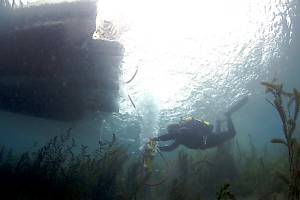Geoarchaeology survey of Spring Lake uncovers new depths of history

Posted by Jayme Blaschke
Office of Media Relations
April 29, 2016
The Meadows Center for Water and the Environment at Texas State University has released findings from a recent underwater geoarchaeology survey of Spring Lake that suggests human history could be much older than previously thought.
A team led by underwater archaeologist Fritz Hanselmann, with support from the National Geographic Society, the Waitt Institute and the Center for Archaeological Studies, conducted the investigation to locate areas of archaeological deposits and develop a picture of how the landscape appeared to ancient humans.
Using a pneumatic post driver and aluminum piping, the team took strategic core soil samples to analyze and provide supplementary data to prior investigations. After determining the age and chemical composition of the soil samples, the team found evidence that suggests a more complex geographical story than anticipated.
“I think the most exciting finding we made was that there was a lake high stand in prehistory,” said Jacob Hooge, project archaeologist. “Between roughly 1,600 and 1,200 years ago, some sort of blockage created a lake of similar depth to today.”
In other words, Spring Lake—formed in 1849 by a man-made dam—once previously existed more than a thousand years ago.
“The blockage could have been a log jam, beaver dam or perhaps even a man-made dam. If nothing else, the discovery presents an interesting research question to pursue in the future—what or who made the prehistoric dam?” said Hooge.
In addition, the report also helps identify new sites to investigate for remains of ancient civilizations.
“We have pinpointed a few strong possibilities for long-term excavation in Spring Lake: the sediment areas surrounding the deepest high pressure spring, known as Deep Hole and exposing a profile from the sediment that was dug decades earlier to install the submersible theaters,” Hanselmann said.
Another exciting find is that several shallow soil samples date to the Paleolithic era.
“Shallower soils containing Paleolithic dates challenge earlier notions of how early or how long people have been here and during which time periods of Texas prehistory,” Hanselmann said. “We're just barely scratching the surface of what we know about past human activity at the springs, especially at the earliest known times of human occupation here. Hopefully future joint terrestrial and underwater efforts will shed even further light on Spring Lake.”
Visit bit.ly/GeoarchaeologySurvey to read the full report.
About The Meadows Center for Water and the Environment
The Meadows Center for Water and the Environment was named following a generous gift from The Meadows Foundation in August 2012. The Meadows Center for Water and the Environment is dedicated to environmental research, stewardship, education and service. The center is led by renowned conservationist Andrew Sansom, Ph.D.